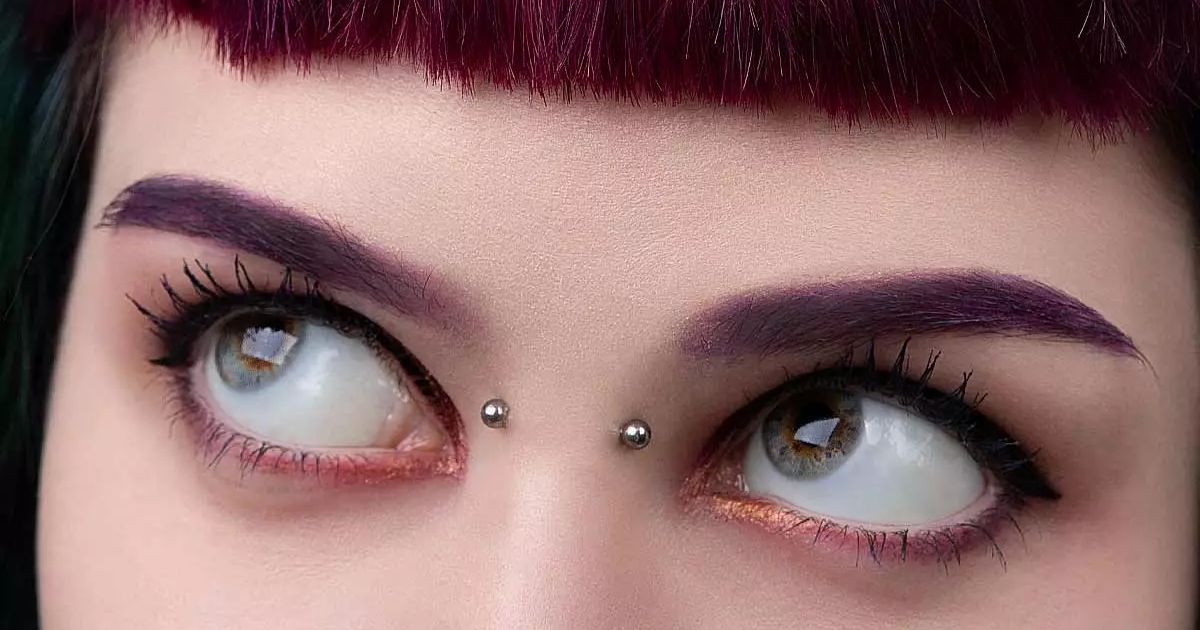Nose bridge piercings, also known as the third eye piercing, can be an edgy and attractive facial piercing when done correctly. A vertical piercing through the bridge of the nose provides a striking focal point on the face for those seeking a bold look. However, as an uncommon piercing, getting a bridge piercing requires care and research to ensure proper placement and minimize risks.
A bridge piercing involves piercing the thin area of cartilage running vertically down the bridge of the nose. When healed, this piercing is commonly adorned with barbells, captive bead rings, or delicate chains depending on personal style. For people able to accommodate the extended healing time and willing to strictly adhere to aftercare, a bridge piercing can create a fashionable facial accent.
What is Bridge Piercing?
A bridge piercing is a body piercing done vertically through the bridge of the nose. This area between the eyes has a section of relatively thin cartilage that can be safely pierced when performed by a highly experienced professional.
The bridge piercing may also be referred to as a:
- Third eye piercing
- Erl or Earl piercing
- Suspension bridge piercing
- Upper nose bridge piercing
While surface piercings like nostril and septum piercings are common, a bridge piercing penetrates deeper through cartilage and tissue for a more dramatic look. Because the bridge of the nose lacks much natural cushioning, bridge piercings require slow, careful healing and a commitment to proper aftercare. But when healed, they create a striking facial feature.
FAST FACT
| PLACEMENT | Across the bridge of the nose |
| PRICING | $30-$40 |
| PAIN LEVEL | 7/10 |
| HEALING TIME | 8-10 weeks |
| AFTERCARE | Clean twice daily with salt water rinse or piercing-friendly cleanser. Avoid touching or twisting. Do not change jewelry until completely healed. |
Bridge Piercing Jewelry
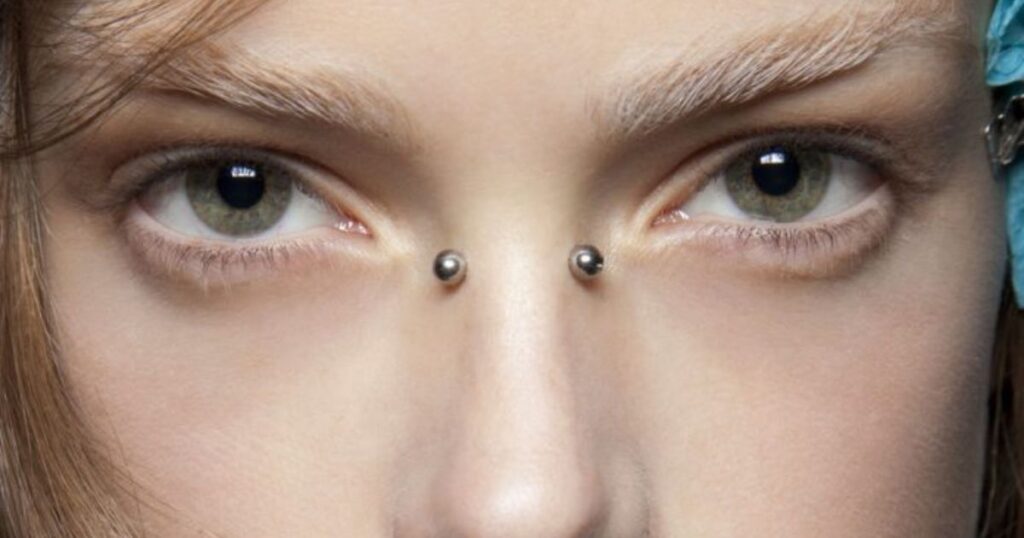
Once a bridge piercing has fully healed, usually after 3-12 months, piercers can insert the initial straight barbell with a pierced eyeball on each end. Decorative options include:
- Captive bead rings
- Curved barbells
- Micro dermal anchors
- Straight or circular barbells
- Delicate chains
- Studs or spikes
Jewelry is commonly made from implant-grade materials like titanium, niobium, or 14k gold. High-quality metals reduce risks of rejection or infection. Jewelry should be fit precisely to avoid friction and allow room for swelling.
Most experts advise against hoop style jewelry until the piercing is well established because hoops can rotate and slow healing. Unique custom pieces can also be ordered online or crafted locally.
History and Origins
While body piercings have existed for centuries, facial and bridge piercings specifically gained popularity in the 1990s through the avant-garde body modification community.
Some cultures see bridge piercings as representing:
- A third psychic eye or sixth chakra
- A rite of passage
- A sign of the divergent or alternative
This less common facial piercing allows wearers to stand out with an unconventional addition. It taps into ideas of edginess, nonconformity, and being open to exploration outside societal norms.
In recent years, bridge piercings have gained more mainstream appeal through celebrity and influencer adoption. But they still make a bold counter-culture statement.
Procedure of Getting a Bridge Piercing
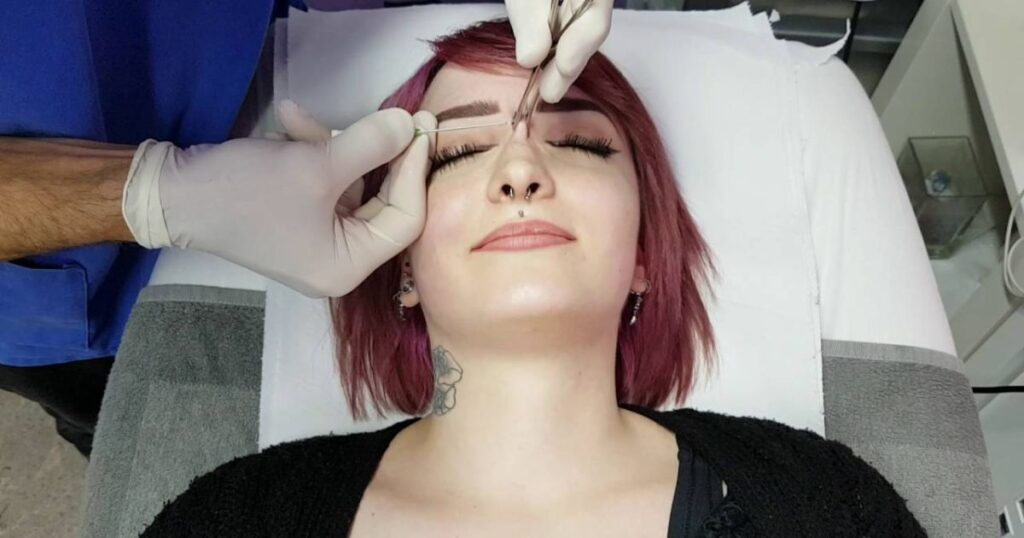
Getting your bridge pierced requires finding an extremely experienced, specialized piercer, ideally with a portfolio of past bridge piercings. It should never be attempted by an amateur.
The process involves:
- Assessment of the nasal anatomy to select the exact placement.
- Marking the entry and exit points with a sterile, disposable marker.
- Thorough sterilization of the piercing equipment and area.
- Using forceps to stabilize the skin.
- Pushing the hollow piercing needle through in one quick motion.
- Inserting the initial jewelry piece carefully.
- Applying light pressure to stop any bleeding.
- Providing detailed home aftercare instructions.
The procedure is relatively quick but finding the ideal placement requires time and skill. This is a delicate area lacking thick skin or tissue.
Bridge Piercing Video Guide
To understand the bridge piercing procedure visually, some instructive videos include:
Bridge Piercing by Calypso Piercing – A step-by-step walkthrough of a professional bridge piercing. Bridge Piercing 101 Guide by Ink180 – Covers piercing terminology, what to expect, and aftercare. Bridge Piercing Experience by Dogstar Tattoo – One client’s first-hand account of the process. How to Pierce a Bridge Piercing by APP – A conference demonstration from the Association of Professional Piercers. Reviewing videos can help you understand exact placement, technique, and what the experience entails. Always visit a qualified piercer though; do not attempt to self-pierce any area.
Bridge Piercing Aftercare and Healing
Caring for a new bridge piercing demands careful attention and patience due to the slow healing process of this area. Essential guidelines include washing hands thoroughly before touching the piercing and using a saline spray or soak 1-2 times daily. It is crucial to avoid using ointments, hydrogen peroxide, alcohol, or creams on the piercing. Additionally, rinsing the piercing after sweating heavily or getting dirty is recommended. While letting shower water run over the piercing is acceptable, direct pressure should be avoided.
Byrdie Tip
Piercing involves the controlled penetration of a surface, commonly associated with body adornment through jewelry or the creation of openings in materials for various purposes.
During the initial healing phase, it’s important to leave the long jewelry in place for several months. Makeup should be skipped around the piercing until it is fully healed, and it’s crucial not to touch, rotate, or handle the jewelry. Sleep disturbances, such as pressing on the piercing, should be avoided, and if significant swelling occurs, taking ibuprofen may be advisable. In case of migration or rejection, it’s essential to consult your piercer promptly. With proper aftercare adherence, bridge piercings can fully heal within 6-12 months. However, impatience or neglecting aftercare measures can prolong the healing process and potentially lead to complications.
How Long Does it Take to Heal?
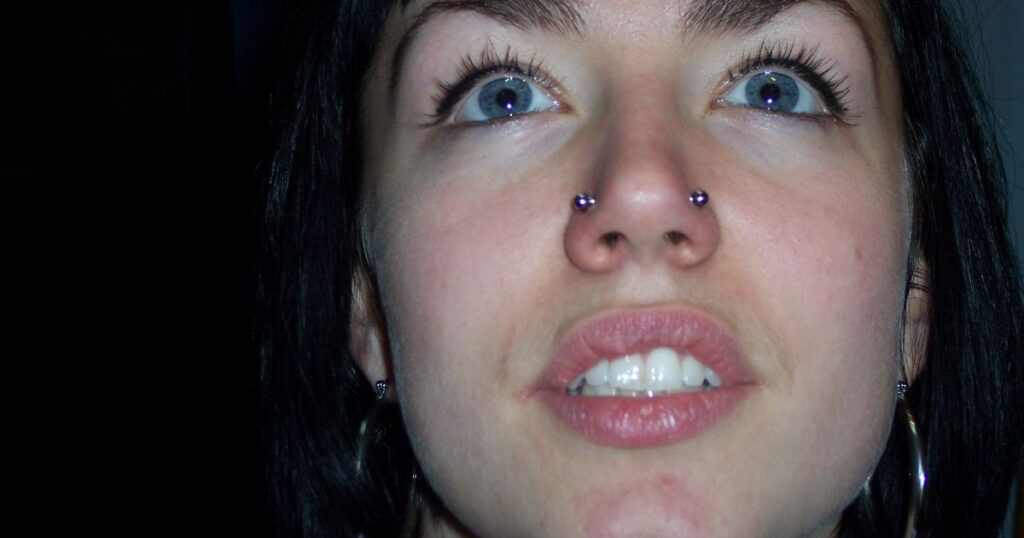
Bridge piercings generally take longer to heal fully compared to ear and facial piercings because the cartilage is thicker than the skin. The expected healing timeline is:
- Initial healing of the wound: 5-6 weeks
- Significant reduction in pain and discharge: 2-3 months
- Adaptation where jewelry can be changed safely: 3-4 months
- Fully healed with minimal crusting or discomfort: 6-12 months
Some factors that can prolong healing include:
- Poor quality jewelry that causes irritation
- Touching or handling the piercing excessively
- Failure to keep the area clean
- Allowing hair products, makeup, or dirt to enter the piercing
- Catching or snagging the jewelry accidentally
- Poor nutrition or lifestyle habits
- Improper initial piercing placement or technique
Patience is required, but with attentive aftercare bridge piercings can heal beautifully.
How Much Does a Bridge Piercing Cost?
Unlike basic earlobe piercings, a bridge piercing is considered more specialized with higher associated costs. The average bridge piercing price ranges from:
- $50 – $80 for the piercing service alone
- $100 – $250 total including jewelry
Factors that increase bridge piercing costs:
- An experienced piercer rather than a novice
- Getting it done at a high-end piercing studio
- Incorporating premium jewelry rather than basic metals
- Having intricate custom jewelry created
- Getting a combination of multiple facial piercings
- Living in areas like Los Angeles or New York City with higher service costs
Price shouldn’t be the priority. An expert piercer using sterile techniques and quality jewelry is worth the investment.
Bridge Piercing Pain
Pain levels can vary significantly depending on individual pain tolerance. However, most people describe bridge piercings as:
- Quick pinching sensation from the needle
- Moderate throbbing pain after piercing
- Feeling of pressure in the first hours and days
- Mild soreness lingering during the healing process
Tips to minimize pain:
- Taking over-the-counter pain relievers
- Using cold compresses to reduce swelling
- Avoiding touching or irritating the area
- Staying hydrated and well rested
- Deep breathing and relaxation techniques
- Distracting yourself with music, videos, or games
For most, the piercing pain settles to mild irritation during the healing months with proper aftercare.
Possible Risks and Complications
Bridge piercings, when performed correctly, typically come with low risks. However, improper technique or inadequate aftercare can lead to various complications. These include bleeding and bruising, which may occur due to excessive force or thin skin; in such cases, applying pressure is recommended. Infection is another potential risk, often caused by unsanitary conditions, and requires prompt medical treatment. Scarring is possible upon removal of the piercing, resulting in small visible scar tissue. Migration or rejection of the jewelry can occur due to poor placement or low-quality jewelry.
Tearing may happen if the jewelry is accidentally pulled on before complete healing. To mitigate these risks and complications, it’s crucial to entrust the procedure and jewelry handling to an expert who follows sterile practices, utilizes proper techniques, and employs sterile equipment.
Bridge Piercing Jewelry Recommendation by Expert
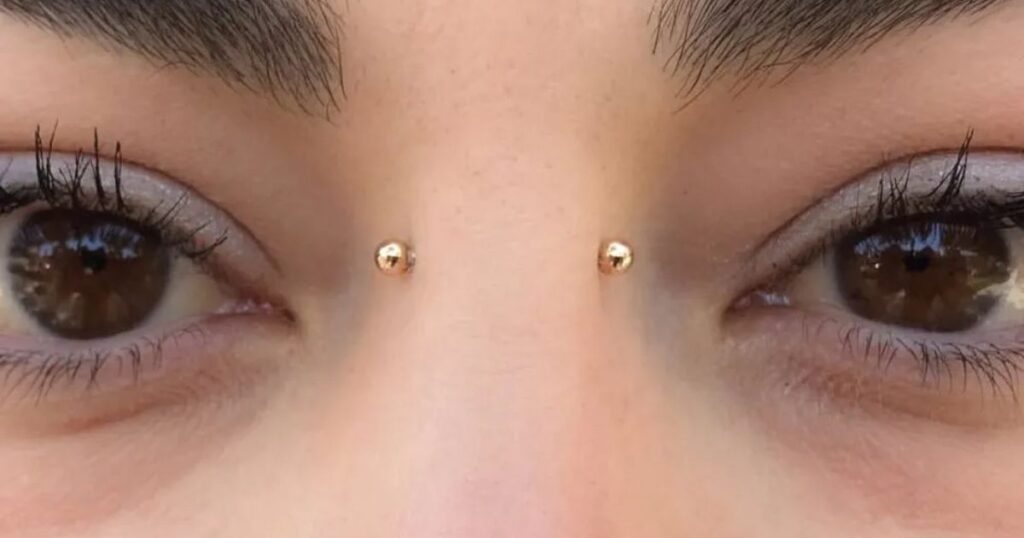
When opting for initial bridge piercing jewelry, it is advisable to adhere to expert recommendations for a safe and comfortable experience. The preferred materials are implant-grade titanium or niobium, chosen for their biocompatibility. The jewelry should be internally threaded or threadless to ensure optimal comfort during the healing process. It is recommended to use barbells with a diameter ranging from 1.6mm to 2mm, allowing for necessary swelling. The length of the barbells should be sufficient to accommodate swelling, leaving ample room between ends.
Curved barbells are preferable over circular rings for the initial phase of the bridge piercing. Following these guidelines ensures not only a stylish choice but also promotes a healthy and smooth healing process for your bridge piercing.
Bridge Piercing Types
There are a few variations of bridge piercings:
Lower Nose Bridge: Pierced through the lower, wider part of the bridge for stability.
Upper Nose Bridge: Pierced higher between the eyes for a dramatic look. More difficult.
Double Bridge: Symmetrical paired piercings on both sides of the upper bridge. Very bold statement.
Earlee or Erl: A diagonal piercing from the bridge through the upper ear cartilage. Combines bridge and orbital.
Hidden or Micro Bridge: Uses a smaller gauge piercing with discreet jewelry. More subtle effect.
Do Bridge Piercing Scars Go Away?

The extent of scarring from a bridge piercing largely depends on various factors. If the piercing successfully heals and is left undisturbed, the resulting scars should be minimal. However, if the piercing is removed or rejected, some light scar tissue may persist. The duration the initial piercing remains in place plays a role, with longer wear minimizing scarring.
The skill of the piercer is crucial, as poor technique can lead to unnecessary trauma. Individual variations in wound healing tendencies also contribute, with some skin prone to more noticeable scars. The manner in which jewelry removal is handled matters, as slow stretching to larger gauges tends to create less scarring than abrupt removal. While scarring in most cases remains subtle and fades with time, the potential for slight visible scarring should be taken into consideration.
Do Bridge Piercings Reject?
Like any piercing, bridge piercings do carry a risk of rejection, particularly among individuals with sensitive skin. However, a skilled and experienced piercer can significantly reduce the likelihood of rejection through several precautionary measures. These include precisely marking the entry and exit points to avoid piercing at an angle, opting for a piercing needle instead of a piercing gun to minimize trauma, selecting an appropriate gauge based on the individual’s anatomy, providing guidance on proper cleaning techniques to prevent over-handling, and ensuring thorough disinfection of both equipment and skin.
Despite the implementation of best practices, rejections may still occur in a small percentage of bridge piercings. If migration or rejection is suspected, it is crucial to seek immediate assistance from the piercer to address and manage the situation effectively.
Bridge Piercing Styling Guide
Once fully healed, bridge piercings offer fun styling options:
Everyday wear: Choose lightweight circular or captive barbells for daily wear.
Edgy look: Try a black spike barbell with points for an edgy vibe.
Dainty and feminine: Opt for a thin, 14k rose gold barbell with cubic zirconia for understated elegance.
Make a statement: Stand out with brightly colored opal or onyx gems in the piercing ends.
Coordination: Match your bridge jewelry metal with other facial piercings.
Festival flair: Incorporate chain designs that shimmer and sway.
Nostalgia: Use barbells with modernized tribal spikes reminiscent of the ’90s.
Gemstone healing: Explore barbells with your preferred spiritual crystals like amethyst or turquoise.
Hoops: Once very well established, add circular captive bead rings for a curved shape.
FAQ’s
What are the negatives of nose bridge piercings?
Bridge piercings take much longer to heal, can leave scarring if removed, may interfere with eyeglasses, and carry a higher risk of rejection compared to some other piercings.
Are bridge piercings hard to heal?
Yes, bridge piercings are known to be one of the more difficult and temperamental facial piercings to heal fully due to limited blood flow and cushioning on the bridge of the nose. They require diligent aftercare.
How often do bridge piercings get rejected?
Rejection rates vary but bridge piercings generally see rejections in 5-15% of piercings, higher than most areas. Poor placement and technique increase the rejection likelihood.
Which piercing hurts the most?
Bridge piercings, cheek piercings, and surface piercings on areas with little muscle or fat generally tend to be reported as the most painful. Pain levels vary based on personal tolerance.
Can I wear eyeglasses with a bridge piercing?
Eyeglasses can potentially be worn with bridge piercings once fully healed, but may require opting for smaller gauge jewelry. Glasses should not rest directly on the piercing until healed.
What does a bridge piercing symbolize?
Bridge piercings are often seen as representing a “third eye”, intuition, unconventionality, and a bold spirit willing to stand out from societal norms. The meaning can vary by individual.
Conclusion
For those seeking a unique facial piercing, bridge piercings can certainly make a dramatic fashion statement and display an edgy style. However, the extended healing period, necessary aftercare, and risks of scarring or rejection mean this piercing option is not for everyone. Do thorough research before getting a bridge piercing to understand proper technique, jewelry sizing, and cleaning. Go to an extremely experienced professional piercer specializing in bridge piercings to minimize complications. While certainly eye-catching, bridge piercings require much more care and patience than average piercings.
